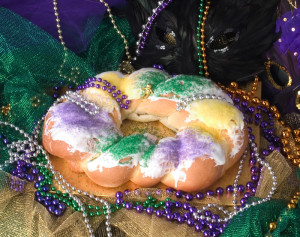Having Your Cake
It’s King Cake season here in New Orleans, and of course there is a historical bent to nearly all of my writing. So I thought I would take a look at the history of King Cakes. Boy was I surprised to see the history of it was far richer than I knew.
King Cakes have been associated with New Orleans and Mardi Gras for centuries. They are those ovals of brioche bread topped with icing and sugared in purple, green, and gold. Sometimes they are stuffed with marvelous fillings and if you have never tried one, you owe it to yourself. But be careful you don’t swallow the plastic baby hidden inside. The tradition is that when the cake is sliced at a party, whoever gets the baby buys the next cake.
The King Cake as we know it today, seems to have originated in Southern France as a version of the Twelfth Night cake that was popular in Europe since Roman times. Twelfth Night is the 5th day of January twelve days after Christmas. Remember the “Twelve Days of Christmas” song? It seems all of Europe had a Twelfth Night tradition with celebrations that included a special cake.
New Orleans has taken its turns being ruled by the French and the Spanish and somehow their traditions for the Twelfth Night cake joined and evolved into the one that New Orleans is known for today, baby and all. Finding the baby can mean anything from buying the next cake, becoming king of the night’s festivities, or in some cases in history even becoming king of carnival.
Of course, such a fun and tasty cake shouldn’t be confined to just one night. Not in New Orleans were everything is celebrated as far as we can take it, right? Laissez les bons temps rouler!-Let the good times roll. So now the cake is served from Twelfth Night all the way up to Mardi Gras Day, which is the day before Ash Wednesday. These days, with the internet, they are shipped worldwide. Local bakeries have reported selling 4,000-5,000 cakes each day during carnival season. Too bad for them that this year’s Mardi Gras comes the earliest it has since 2008. (The 9th of February if you are curious.)
Join me in my next blog when I go farther back to look at the wider tradition of the Twelfth Night cake.

